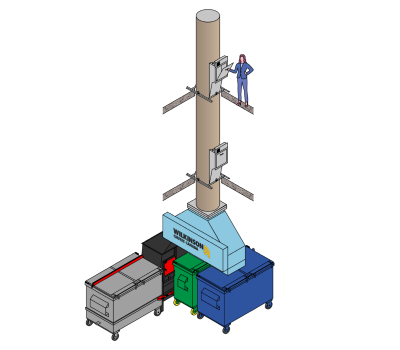Cardboard Baler Rental to Optimize Your Recycling Processes
Cardboard Baler Rental to Optimize Your Recycling Processes
Blog Article
Discovering the Necessary Duty of Waste Devices in Modern Recycling Processes and Sustainable Waste Disposal Practices
The vital role of waste tools in modern-day reusing processes underscores its significance in achieving lasting waste disposal practices. As the demand for even more lasting solutions expands, it is necessary to take a look at just how these modern technologies adjust to progressing difficulties within waste management - baler rental.
Relevance of Waste Tools
Why is waste devices vital in the reusing process? The efficiency of reusing procedures pivots significantly on the schedule and capability of waste tools. This category of equipment and tools is important for the efficient collection, handling, and sorting of recyclable products. By facilitating the separation of materials, waste tools reduces contamination, which is critical in making certain high-quality recyclables that can be reestablished right into producing cycles.
Moreover, waste equipment enhances operational effectiveness and security within recycling facilities. Advanced equipment, such as shredders and balers, enables for the fast handling of large quantities of waste, reducing labor costs and processing time. On top of that, using customized equipment decreases the danger of injury amongst workers by automating hazardous jobs.
Furthermore, the ecological impact of recycling is amplified by reliable waste tools. By maximizing the recycling procedure, centers can dramatically lower the quantity of waste sent out to landfills, therefore adding to sustainability efforts. In verdict, waste equipment is not just a supplementary element of reusing; it is an essential facet that drives effectiveness, safety and security, and ecological stewardship in modern waste monitoring practices.
Sorts Of Waste Tools
The performance of recycling procedures is very closely linked to the details kinds of waste devices utilized while doing so. baler rental. Numerous groups of devices are important to the collection, arranging, processing, and transportation of recyclable products
Firstly, collection devices, such as waste collection trucks and containers, is necessary for collecting recyclables from different resources, consisting of property, business, and industrial areas. As soon as collected, sorting tools, consisting of conveyor belts, shredders, and magnetic separators, plays a vital function in identifying various material types, guaranteeing that pollutants are gotten rid of before handling.
Handling equipment, such as balers and compactors, further prepares materials for reusing by compressing and packaging them right into workable dimensions. This not just enhances space but additionally improves transportation effectiveness. Additionally, specialized equipment like granulators and extruders is used for changing products right into recyclable types, particularly in plastic recycling.

Duty in Recycling Procedures
In reusing procedures, the duty of waste equipment is essential in making sure performance and efficiency at every phase. This equipment encompasses a variety of equipment created to handle, process, and type materials that are to be reused. The initial stage involves collection and transportation, where compactors and balers play a crucial role in optimizing the quantity of materials for transit, thus lowering functional costs.
As soon as at the recycling center, shredders and crushers enter play, breaking down materials into workable dimensions appropriate for additional processing. have a peek at this website These equipments add to enhancing the area of recyclables, promoting extra effective material healing. Arranging systems, geared up with advanced innovations such as conveyor belts and optical sensing units, make sure that products are properly divided by kind, thereby making the most of the quality of the recycled final product.
Additionally, specialized equipment for processing details products-- such as glass, plastics, and steels-- ensures that each type is taken care of in one of the most effective fashion. In general, the integration of sophisticated waste tools right into the reusing process not just improves procedures however additionally considerably adds to the overall recuperation rates of useful materials, underscoring its necessary function in modern recycling efforts.
Effect on Sustainable Practices
Through the effective operation of waste equipment, reusing procedures considerably enhance lasting techniques throughout different markets. This influence is recognized through raised material recuperation rates, which lower the need for virgin resources. By improving sorting and processing functions, progressed waste devices lessens contamination in recyclable products, therefore boosting the high quality of recycled result. The decrease of waste sent to garbage dumps is one more crucial advantage, as it minimizes ecological degradation and minimizes greenhouse gas exhausts related to decay.

Moreover, the assimilation of wise technologies in waste monitoring systems enables real-time information tracking and evaluation, causing even more enlightened decision-making and functional performances. As sectors increasingly focus on sustainability, the duty of waste tools ends up being paramount fit practices that align with environmental stewardship and regulatory conformity. Inevitably, the synergy in between waste devices and recycling procedures plays an important function beforehand wider sustainability objectives across neighborhoods and markets alike.
Future Patterns in Waste Management
Arising trends in waste monitoring are poised to improve the landscape of reusing and resource recovery substantially. One of one of the most critical shifts is the combination why not find out more of sophisticated innovations such as expert system, device discovering, and the Net of Things (IoT) These technologies help with enhanced arranging processes, improving the efficiency and accuracy of recycling procedures. Smart waste bins furnished with sensors can keep an eye on waste degrees in real-time, maximizing collection courses and reducing operational prices.
Furthermore, the round economic situation model is getting grip, advertising the idea of recycling products instead of taking care of them. This pattern urges companies to design products with end-of-life considerations in mind, driving the demand for ingenious waste administration services.
Moreover, public recognition and engagement in sustainability practices are on the increase, resulting in raised participation in reusing programs. Federal government plans are also progressing, with more stringent regulations on waste disposal and incentives for sustainable practices.
As these trends assemble, they produce a more effective, lasting waste monitoring system that not just minimizes ecological impact however additionally cultivates economic growth via source recovery and innovation in waste equipment. The future of waste monitoring looks encouraging, driven by technology and a dedication to sustainability.
Final Thought
In conclusion, waste tools plays a crucial duty in improving the performance and effectiveness of modern recycling procedures. By minimizing contamination and making best use of product recovery, advanced machinery supports lasting waste disposal practices and promotes a round economic situation. The unification of clever technologies additionally enhances these initiatives, guaranteeing liable ecological stewardship. As waste administration continues to develop, the value of cutting-edge waste tools will certainly remain critical in attaining sustainability objectives and dealing with the obstacles of source exhaustion.
Report this page